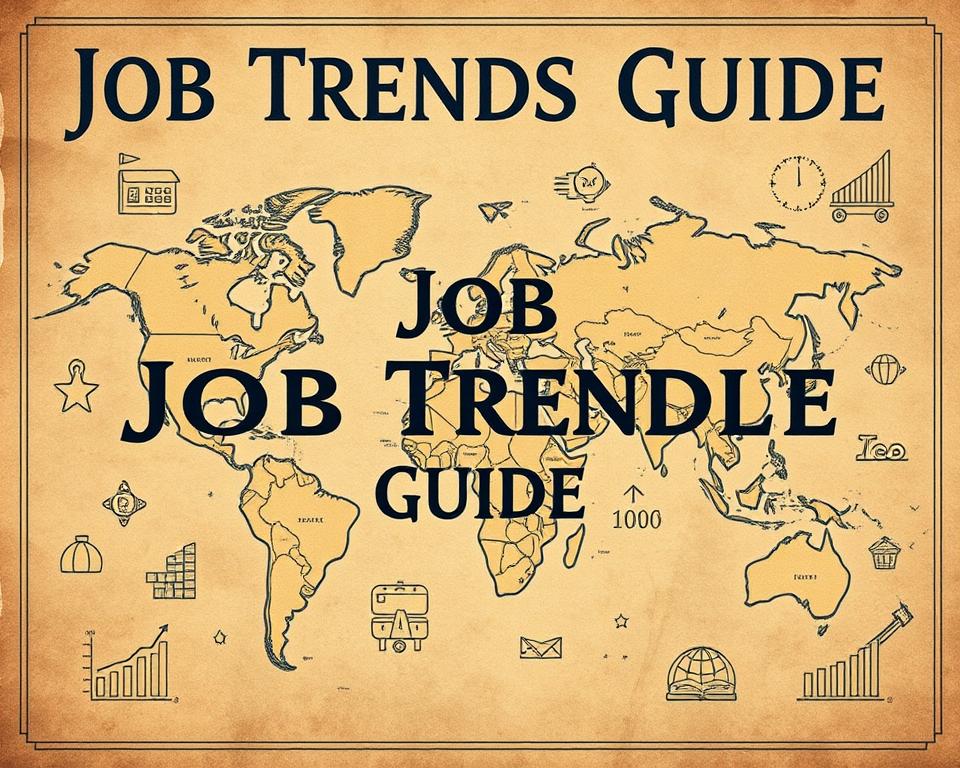Anuncios
¿Alguna vez te preguntaste por qué tantos currículos desaparecen antes de que alguien los lea?
Saber cómo funciona la contratación hoy en día Convierte la confusión en acción. Las empresas pueden recibir alrededor de 250 currículums por vacante, y solo alrededor de 2% reciben una llamada. Los reclutadores suelen escanear el currículum durante aproximadamente seis segundos, y los sistemas de seguimiento de candidatos almacenan los currículums para que los equipos puedan buscar por palabras clave específicas.
Esto significa que te centrarás en acciones claras y específicas que mejoren tus posibilidades rápidamente. Aprenderás a elegir términos que ayuden a que tu currículum aparezca en las bases de datos y que los empleadores puedan identificar fácilmente tu perfil.
También crearás un plan sencillo que integre la investigación, la segmentación y los mensajes personalizados en un sistema semanal repetible. El objetivo es obtener resultados constantes y medibles, y más entrevistas con cada solicitud.
Cómo funciona realmente la búsqueda de empleo hoy en día en Estados Unidos
Comprender cómo las herramientas de contratación modernas buscan y clasifican los currículos le ayudará a diseñar solicitudes que destaquen.
Anuncios
Grandes empleadores Importar currículums a un sistema de seguimiento de solicitantes Y luego buscar, ordenar y filtrar a los solicitantes por palabras clave. La mayoría de las publicaciones generan alrededor de 250 currículums, pero solo unos 2% reciben llamadas. Por eso, es fundamental usar un lenguaje adecuado.
Los reclutadores usan LinkedIn y los principales motores de búsqueda para encontrar candidatos y evaluar sus nombres. Casi la mitad de los empleadores no se pondrán en contacto contigo si no te encuentran en línea.
- Aprenderá cómo ATS almacena su currículum y por qué es importante colocar títulos y certificaciones exactos.
- Verá cómo los reclutadores realizan búsquedas en LinkedIn y Google para localizar rápidamente candidatos calificados.
- Comprenderá por qué el escaneo de seis segundos favorece títulos limpios, diseños claros y una redacción precisa.
Para obtener una guía práctica sobre la búsqueda y la difusión digitales modernas, consulte esto guía de búsqueda digital.
Investigue y elija las palabras clave adecuadas antes de presentar la solicitud.
Empieza por mapear lo que la gente realmente escribe cuando busca puestos como el tuyo. Usa herramientas como Planificador de palabras clave de Google y Palabras clave en todas partes Para consultar el volumen de búsqueda y el interés regional. Esto muestra qué términos coinciden con la intención de búsqueda en tu ciudad o estado.

Elija títulos sencillos y que se puedan buscar — "Desarrollador Java" supera a trucos como "Desarrollador Ninja de TI". Use títulos completos en lugar de abreviaturas (por ejemplo, "Vicepresidente Sénior de Finanzas" en lugar de "Vicepresidente Sénior de Finanzas") para que los sistemas de seguimiento de candidatos (ATS) y los motores de búsqueda representen su experiencia correctamente.
- Enumere las herramientas y habilidades exactas que escriben los empleadores, como “Microsoft Excel”, “Outlook” o nombres de software específicos.
- Incluya variantes de ubicación (ciudad, nombre completo del estado, abreviatura común, código postal) para aumentar la visibilidad local.
- Escanee varias ofertas de trabajo para crear un banco de palabras clave breve con títulos, certificaciones y términos que reutilizará.
Aplicar palabras clave en contexto — integre los términos de forma natural en viñetas cortas o líneas de logros para que tanto los sistemas como los gerentes de contratación vean cómo utilizó las habilidades en el puesto.
Optimice su currículum para ATS y personas reales
Coloque las credenciales correctas donde serán vistas primero, por el software y por los humanos. Incluya las certificaciones, licencias y herramientas imprescindibles en un breve resumen de cualificaciones cerca de la parte superior. Esto facilita que los sistemas de seguimiento de candidatos y los análisis humanos rápidos encuentren rápidamente lo esencial.
Escribe palabras clave en contexto. Vincula habilidades específicas con logros para demostrar cómo usaste una herramienta o certificado para obtener resultados. Palabras simples como "Reducción del tiempo de procesamiento 30% con el software XYZ" son más efectivas que largas listas de palabras sin relación.
Evite el relleno y las palabras clave innecesarias. Reduzca las frases de relleno y refleje la redacción de la publicación para optimizar el seguimiento de las coincidencias de los candidatos. Incluya los detalles más importantes en encabezados, un breve resumen y una sección de calificaciones para captar la atención durante un análisis de seis segundos.
- Coloque licencias y palabras clave de alto valor en la parte superior para ayudar a obtener visibilidad del currículum para los solicitantes y los reclutadores.
- Incorpore palabras clave a sus logros para que demuestren su impacto y no aparezcan simplemente como palabras.
- Mantenga el formato limpio, las etiquetas estándar y ejecute una pasada final para pulir la claridad y los resultados de la búsqueda.
Desarrolla un SEO personal para que los empleadores puedan encontrarte
Facilite a las personas y a los sistemas la búsqueda de su perfil creando una presencia online consistente.

Crea un titular para LinkedIn Que describa tu puesto objetivo y dos habilidades clave. Por ejemplo: "Scrum Master / Gerente de Proyectos de TI Ágiles". Este formato te ayuda a aparecer en los resultados de búsqueda y en los filtros de reclutamiento.
Crea un título de LinkedIn que resalte tu puesto y tus habilidades objetivo.
Mantenlo claro y fácil de buscar. Usa títulos sencillos y un par de herramientas o certificaciones. Esto aumenta la visibilidad en la red social profesional y en las búsquedas.
Aproveche las habilidades y recomendaciones de LinkedIn para reforzar las palabras clave
Activa habilidades de alta relevancia para que las recomendaciones respalden tu titular. Las personas que revisan tu perfil y sistemas evalúan esas entradas.
Mantenga su nombre profesional consistente en todas las plataformas
Usa el mismo nombre en tu currículum, LinkedIn y redes sociales. Casi la mitad de los empleadores tienen menos probabilidades de contactarte si no te encuentran en línea.
Corrija la ortografía y la gramática para que el texto siga siendo buscable.
Palabras clave como "gerente" o "ingeniero" pueden perderse en los resultados de búsqueda si se escriben mal. Añade una URL personalizada de LinkedIn a tu firma de correo electrónico y a tu currículum, y publica selectivamente sobre proyectos para que te encuentren.
Presentar solicitudes de forma más inteligente: adaptar, hacer seguimiento y reforzar cada envío
Haga que cada solicitud cuente reflejando exactamente el lenguaje y formato del empleador. Lea la descripción del puesto y copie los títulos y la redacción de la certificación. Por ejemplo, utilice "gerente de proyecto" si aparece ese término; no lo sustituya por abreviaturas como "gerente de proyecto".
Personalice los currículums para reflejar con precisión la descripción de cada puesto
Coincidir con términos, no sólo con significados. Refleje los requisitos principales del puesto en su resumen y viñetas para que los sistemas de seguimiento de solicitantes y los revisores humanos vean que se ajustan a los mismos.
Guarde una versión personalizada para cada publicación y etiquete los archivos con claridad (Nombre_Apellido_Rol_Empresa). Esto mantiene la coherencia de la información clave en todos los materiales y le permite ajustar la redacción cuando las coincidencias exactas mejoran los resultados.
Configurar un sistema de seguimiento simple para administrar publicaciones y respuestas
Crea una hoja básica para registrar las ofertas de empleo, las fechas, la versión del currículum y los resultados. Registra las palabras clave que usaste y las solicitudes que resultaron en entrevistas.
- Refleje el lenguaje de la descripción del trabajo para que la correspondencia automatizada y los humanos estén alineados.
- Cree un flujo de trabajo de adaptación reutilizable que resalte los requisitos principales.
- Configure recordatorios de calendario para realizar un seguimiento y mantener su canalización en movimiento.
Para acelerar las personalizaciones, prueba herramientas que sugieren coincidencias automáticamente y producen borradores personalizados, como Herramientas de IA para aplicaciones personalizadasPruebe pequeñas variaciones en los resúmenes y viñetas para descubrir qué mejora su visibilidad y sus resultados de búsqueda.
Consejos prácticos para la búsqueda de empleo para principiantes
Elija un rol objetivo claro y utilice pasos pequeños y repetibles para conseguir entrevistas antes.
Tu lista de verificación de inicio rápido para obtener resultados esta semana
“Utilice un lenguaje preciso para el empleador, incluya palabras clave de alto valor al principio y mantenga un nombre coherente para que lo encuentren fácilmente”.
- Define tu rol objetivo y guarda tres publicaciones como ejemplos para crear una lista de palabras clave enfocada para la semana.
- Reescribe tu título de LinkedIn para tu industria y agrega entre 10 y 15 habilidades específicas, como Excel y Outlook.
- Actualice el resumen de su currículum con dos palabras clave que utilizan los líderes laborales y un resultado cuantificado para mejorar los resultados de búsqueda.
- Agregue tres logros específicos del rol con números debajo de su puesto más reciente para mostrar el impacto a los empleadores.
- Ejecute una revisión ortográfica y confirme la coherencia del nombre en el currículum, LinkedIn y correo electrónico para que no se filtre a nadie que busca empleo.
- Incluya variaciones de ubicación (ciudad, estado, abreviatura) en su encabezado para aumentar la visibilidad de la búsqueda local.
- Postúlese para tres puestos esta semana con currículums personalizados, haga un seguimiento de los envíos y tome nota de qué cambios produjeron entrevistas.
- Envíe dos notas de networking bien pensadas a ex alumnos o candidatos de la industria para aprender y abrir puertas.
Acciones pequeñas y enfocadas Esta semana, mejora tu visibilidad en las búsquedas y tu confianza. Repite la lista de verificación cada semana y evalúa qué ejemplos y palabras clave son más efectivos para quienes buscan empleo.
Conclusión
Considere cada publicación como un pequeño experimento: Compare títulos y certificaciones exactos, registre sus cambios y mida qué solicitudes le permiten entrevistarse. Esto convierte la investigación en resultados repetibles y mantiene su búsqueda de empleo enfocada.
Mantén la coherencia en tu currículum, LinkedIn y redes sociales para que los empleadores y los sistemas de seguimiento de candidatos encuentren el mismo nombre y términos. Corrige la ortografía y usa palabras clave claras y contextualizadas en viñetas cortas para demostrar tu impacto.
Evite los trucos. Use nombres de roles sencillos, haga seguimiento semanal de los resultados y refine las frases que funcionen. Las pequeñas mejoras constantes en el seguimiento, la calidad de la información y la alineación se traducen en mejores resultados con los reclutadores y los equipos de contratación.



